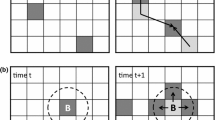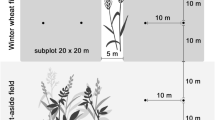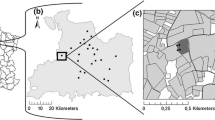Abstract
We studied the response of carabid species richness and density to landscape simplification (measured as percentage cover of non-crop habitat surrounding each study site) in 36 wheat fields using pitfall traps. Carabids were divided to trophic groups following the literature. The number of species from different trophic groups declined with increasing landscape simplification in the order: carnivores > phytophages > omnivores. Density compensation of both carnivores and phytophages suggests that species decline is caused by the loss of specific resources rather than by an overall reduction in food availability. Increasing evenness indicates that a greater share of phytophagous species contributes to density compensation at poorer sites. A comparison with data from complementing studies shows that marked differences in species numbers (carnivores > omnivores > phytophages) are due to a different sensitivity of trophic groups to agricultural management. Since our findings seem to be partly due to increasing sensitivity to landscape changes with trophic rank, and partly to decreasing sensitivity of depauperate communities to local environmental stress, species loss can best be explained by the co-action of factors at local and regional scales. Species richness decline might significantly alter the role of carabids as biocontrol agents.


Similar content being viewed by others
References
Bengtsson J, Engelhart K, Giller P, Hobbie S, Lawrence D, Levine J, Vilà M, Wolters V (2002) Slippin’ and slidin’ between the scales: the scaling components of biodiversity-ecosystem functioning relations. In: Loreau M, Inchausti P, Naeem S (eds) Biodiversity and ecosystem functioning: synthesis and perspectives. Oxford University Press, Oxford, pp 209–220
Bestelmeyer BT, Miller JR, Wiens JA (2003) Applying species diversity theory to land management. Ecol Appl 13:1750–1761
Bohan DA, Bohan AC, Glen DM, Symondson WOC, Wiltshire CW, Hughes L (2000) Spatial dynamics of predation by carabid beetles on slugs. J Anim Ecol 69:367–379
Bommarco R (1999) Feeding, reproduction and community impact of a predatory carabid in two agricultural habitats. Oikos 87:89–96
Borrvall C, Ebenman B, Jonsson T (2000) Biodiversity lessens the risk of cascading extinction in model food webs. Ecol Lett 3:131–136
Bruun HH (2000) Patterns of species richness in dry grassland patches in an agricultural landscape. Ecography 23:641–650
Cole LJ, McCracken DI, Dennis P, Downie IS, Griffin AL, Foster GN, Murphy KJ, Waterhouse T (2002) Relationships between agricultural management and ecological groups of ground beetles (Coleoptera: Carabidae) on Scottish farmland. Agric Ecosyst Environ 93:323–336
Dauber J, Hirsch M, Simmering D, Waldhardt R, Otte A, Wolters V (2003) Landscape structure as an indicator of biodiversity: matrix effects on species richness. Agric Ecosyst Environ 98:321–329
Desender K (1982) Ecological and faunal studies on Coleoptera in agricultural land II. Hibernation of Carabidae in agro-ecosystems. Pedobiologia 23:295–303
Dombos M (2001) Collembola of loess grassland: effects of grazing and landscape on community composition. Soil Biol Biochem 33:2037–2045
Dunning JB, Danielson BJ, Pulliam HR (1992) Ecological processes affect populations in complex landscapes. Oikos 65:169–175
Findley JS, Findley MT (2001) Global, regional, and local patterns in species richness and abundance of butterflyfishes. Ecol Monogr 71:69–91
Fournier E, Loreau M (2002) Foraging activity of the carabid beetle Pterostichus melanarius Ill. in field margin habitats. Agric Ecosyst Environ 89:253–259
Gabriel D, Thies C, Tscharntke T (2002) Scale-dependent effects of landscape structure on plant diversity in cereal fields. Verh Ges Ökol 32:352
Gaston KJ, Lawton JH (1990) Effects of scale and habitat on the relationship between regional distribution and local abundance. Oikos 58:329–335
Gustafson EJ (1998) Quantifying landscape spatial pattern: what is the state of the art? Ecosystems 1:143–156
Holt RD, Lawton JH, Polis GA, Martinez ND (1999) Trophic rank and the species-area relationship. Ecology 80:1495–1504
Honek A, Martinkova Z, Jarosik V (2003) Ground beetles (Carabidae) as seed predators. Eur J Entomol 100:531–544
Jeanneret PH, Schüpbach B, Luka H (2003) Quantifying the impact of landscape and habitat features on biodiversity in cultivated landscapes. Agric Ecosyst Environ 98:311–320
Jongman RHG (2002) Homogenisation and fragmentation of the European landscape: ecological consequences and solutions. Landsc Urban Plan 58:211–221
Jorgensen HB, Toft S (1997) Role of granivory and insectivory in the life cycle of the carabid beetle Amara similata. Ecol Entomol 22:7–15
Kareiva P (1994) Space: the final frontier for ecological theory. Ecology 75:1
Kromp B (1999) Carabid beetles in sustainable agriculture: a review on pest control efficacy, cultivation impacts and enhancement. Agric Ecosyst Environ 74:187–228
Kruess A (2003) Effects of landscape structure and habitat type on a plant-herbivore-parasitoid community. Ecography 26:283–290
Lagerlöf J, Goffre B, Vincent C (2002) The importance of field boundaries for earthworms (Lumbricidae) in the Swedish agricultural landscape. Agric Ecosyst Environ 89:91–103
Lawton JH, Brown VK (1993) Redundancy in ecosystems. In: Schulze ED, Mooeney HA (eds) Biodiversity and ecosystem function. Springer, Berlin Heidelberg New York, pp 255–270
Lindroth CH (1992) Ground beetles (Carabidae) of Fennoscandia: a zoogeographic study. Part I. Specific knowledge regarding the species. Intercept, Andover, UK
Marshall EJP, Brown VK, Boatman ND, Lutman PJW, Squire GR, Ward LK (2003) The role of weeds in supporting biological diversity within crop fields. Weed Res 43:77–89
McGrady-Steed J, Morin PJ (2000) Biodiversity, density compensation, and the dynamics of populations and functional groups. Ecology 82:361–373
Östman Ö (2002) Landscape and farm management influence generalist predators: effects on condition, abundance and biological control. Acta Univ Agric Suec Agr, p 363
Östman Ö, Ekbom B, Bengtsson J (2001) Natural enemy impacts on a pest aphid varies with landscape structure and farming practice. Basic Appl Ecol 2:365–371
Purtauf T, Dauber J, Wolters V (2004) Carabid communities in the spatio-temporal mosaic of a rural landscape. Landsc Urban Plan 67:185–193
Ribera I, Dolédec S, Downie IS, Foster GN (2001) Effect of land disturbance and stress on species traits of ground beetle assemblages. Ecology 82:1112–1129
Ritchie M, Olff H (1999) Spatial scaling laws yield a synthetic theory of biodiversity. Nature 400:557–560
Ruesink JL, Srivastava DS (2001) Numerical and per capita responses to species loss: mechanisms maintaining ecosystem function in a community of stream insect detritivores. Oikos 93:221–234
Scheffer M, Carpenter S, Foley JA, Folke C, Walker B (2001) Catastrophic shifts in ecosystems. Nature 413:591–596
Schmidt MH, Lauer A, Purtauf T, Thies C, Schäfer M, Tscharntke T (2003) Relative importance of predators and parasitoids for cereal aphid control. Proc R Soc Lond B Biol Sci 270:1905–1909
Skuhravý V (1959) Die Nahrung der Feldcarabiden. Acta Soc Entomol Cech 56:1–18
Southwood TRE, Henderson PA (2000) Ecological methods. Blackwell, Oxford
Stanners D, Bordeau P (1995) Europe’s environment: the Dobris assessment. European Environmental Agency, Copenhagen
Symondson WOC, Glen DM, Ives AR, Langdon CJ, Wiltshire CW (2002) Dynamics of the relationship between a generalist predator and slugs over five years. Ecology 83:137–147
Thiele HU (1977) Carabid beetles in their environments. Springer, Berlin Heidelberg New York
Thies C, Steffan-Dewenter I, Tscharntke T (2003) Effects of landscape context on herbivory and parasitism at different spatial scales. Oikos 101:18–25
Tischendorf L (2001) Can landscape indices predict ecological processes consistently? Landsc Ecol 16:235–254
Turner MG, Gardner RH, O’Neill RV (2001) Landscape ecology in theory and practice: pattern and process. Springer, Berlin Heidelberg New York
Wallin H, Ekbom BS (1988) Movements of carabid beetles (Coleoptera: Carabidae) inhabiting cereal fields: a field tracing study. Oecologia 77:39–43
Weibull AC, Östman Ö, Granqvist A (2003) Species richness in agroecosystems: the effect of landscape, habitat and farm management. Biodivers Conserv 12:1335–1355
Wolters V (2001) Biodiversity of soil fauna and its function. Eur J Soil Biol 37:221–227
Woodward G, Hildrew AG (2002) Food web structure in riverine landscapes. Freshw Biol 47:777–798
Acknowledgements
We thank Manfred Hollenhorst for help with the statistics. This study was funded by the German Science Foundation (Deutsche Forschungsgemeinschaft) in the context of the ‘Sonderforschungsbereich 299’ and by the German Ministry of Education and Research (BMBF) in the context of the project ‘Biodiversity and Spatial Complexity in Agricultural Landscapes under Global Change’ (BIOPLEX). The study complies with the current laws of Germany.
Author information
Authors and Affiliations
Corresponding author
Appendix
Appendix
Table 2 lists all of the species recorded during this study
Rights and permissions
About this article
Cite this article
Purtauf, T., Dauber, J. & Wolters, V. The response of carabids to landscape simplification differs between trophic groups. Oecologia 142, 458–464 (2005). https://doi.org/10.1007/s00442-004-1740-y
Received:
Accepted:
Published:
Issue Date:
DOI: https://doi.org/10.1007/s00442-004-1740-y




